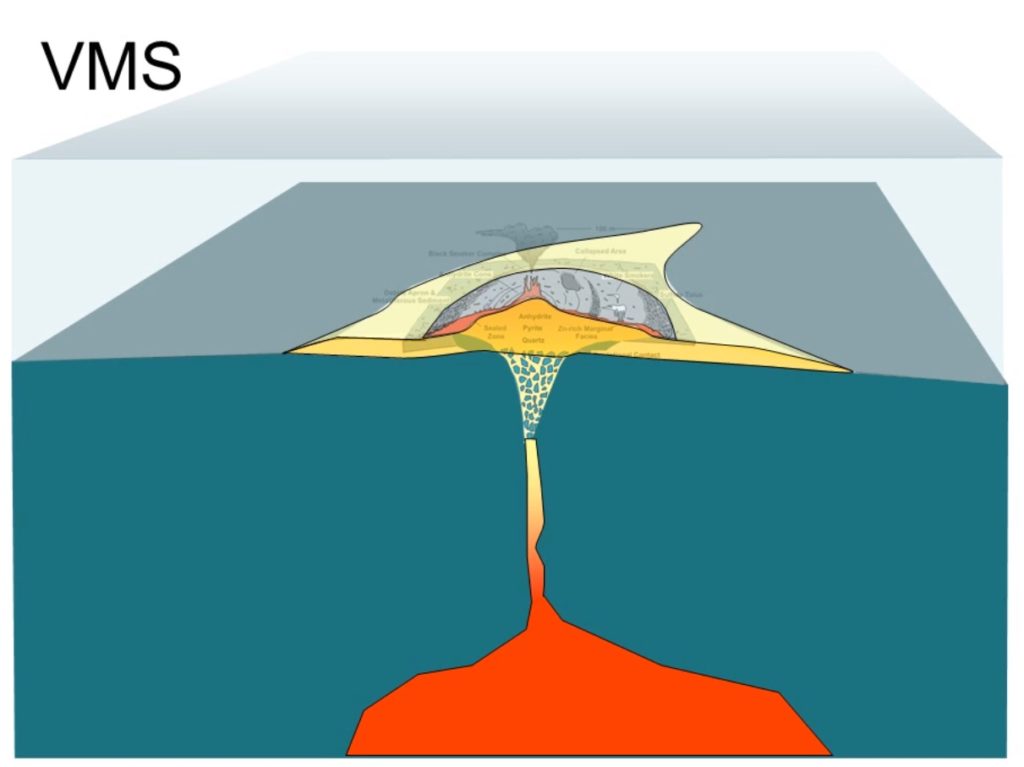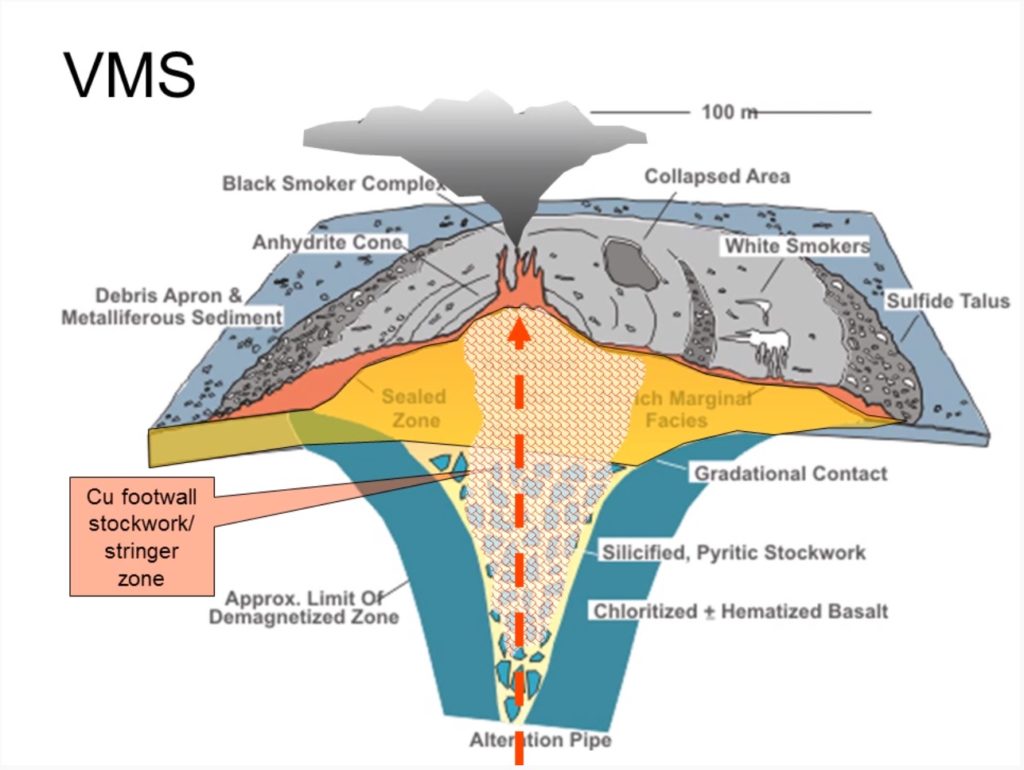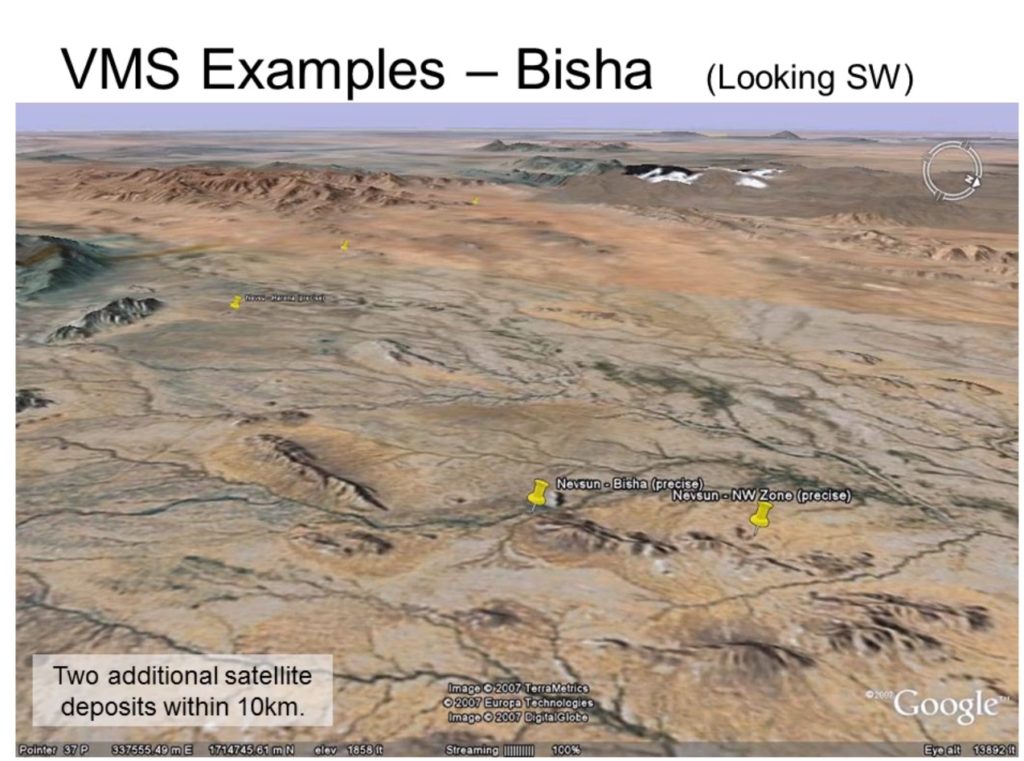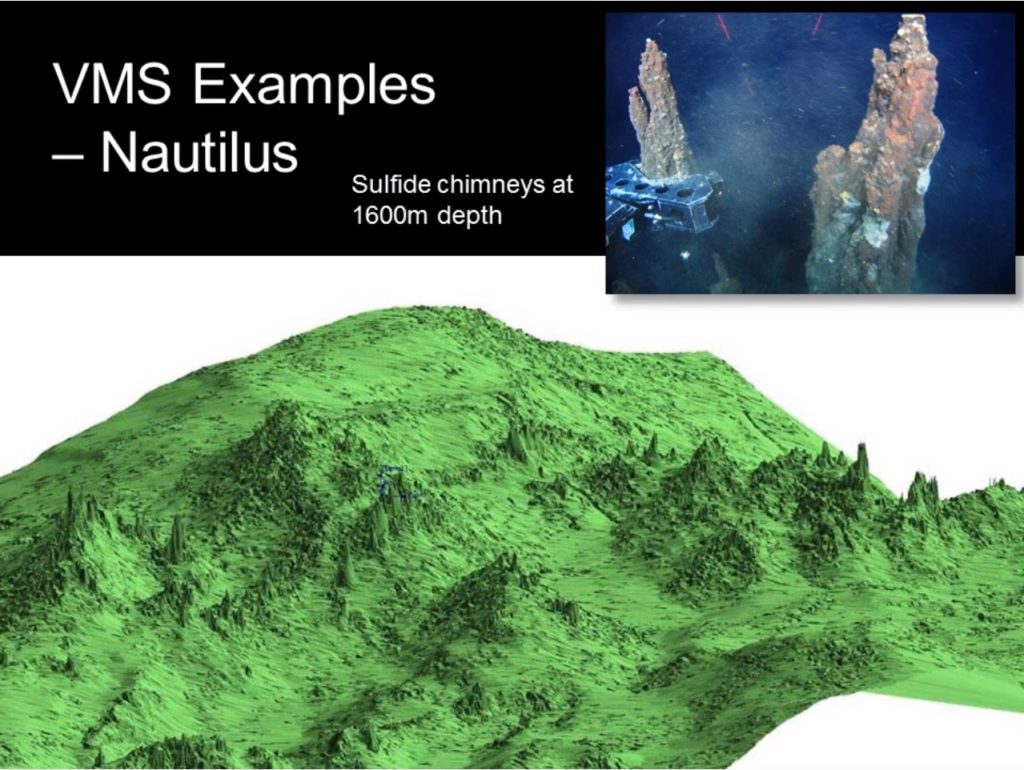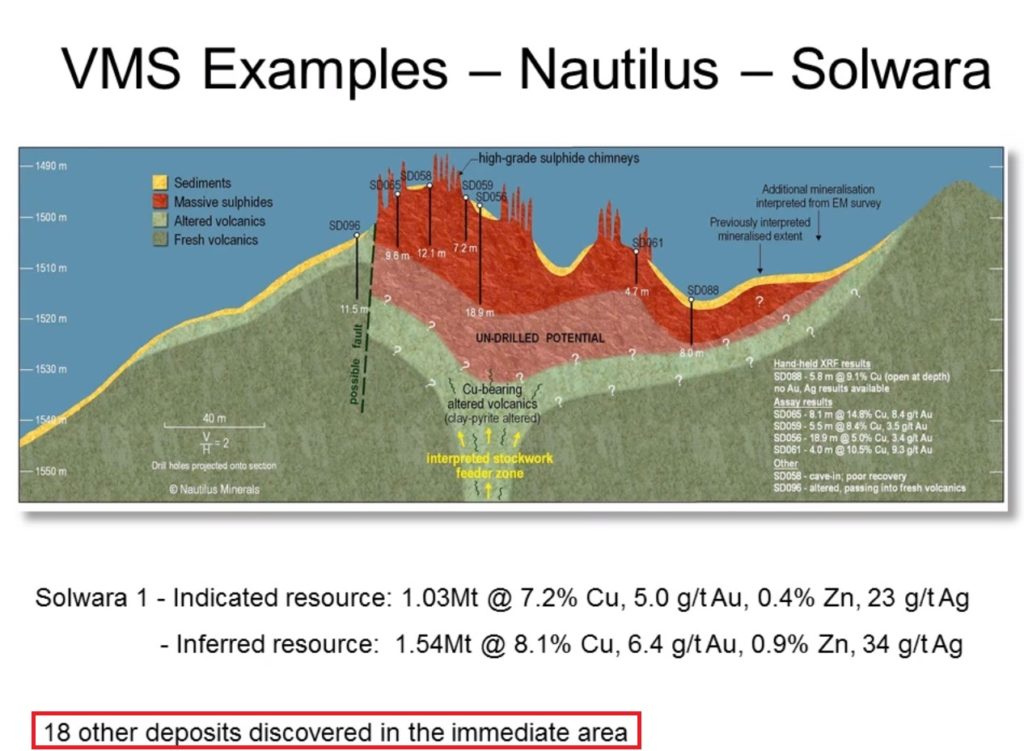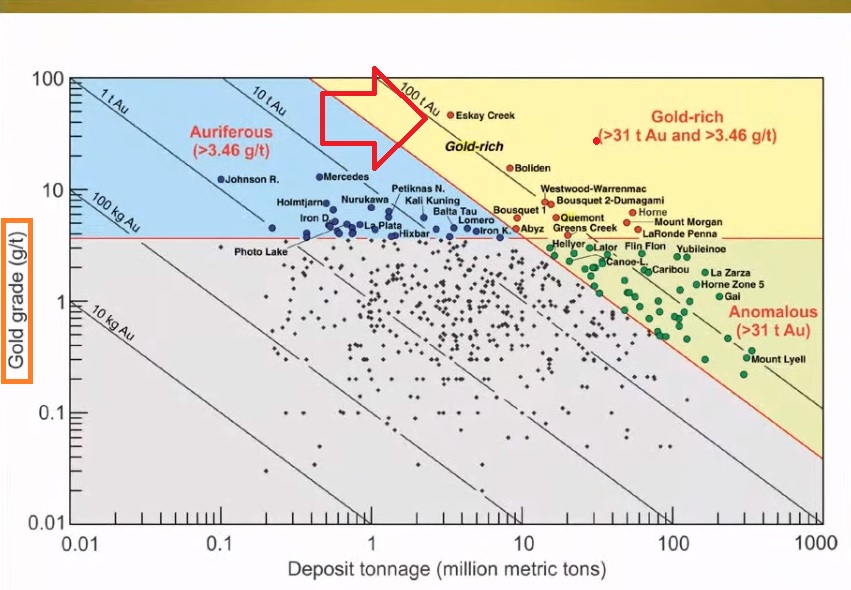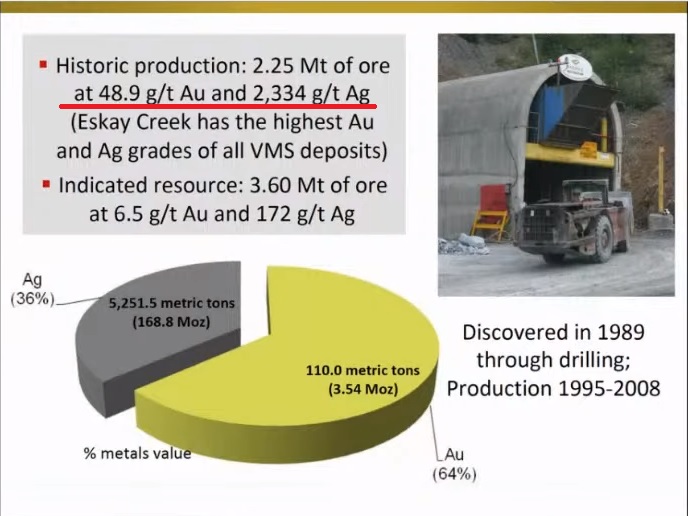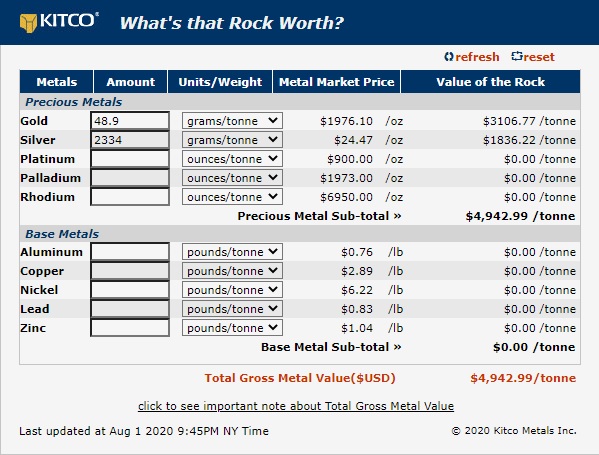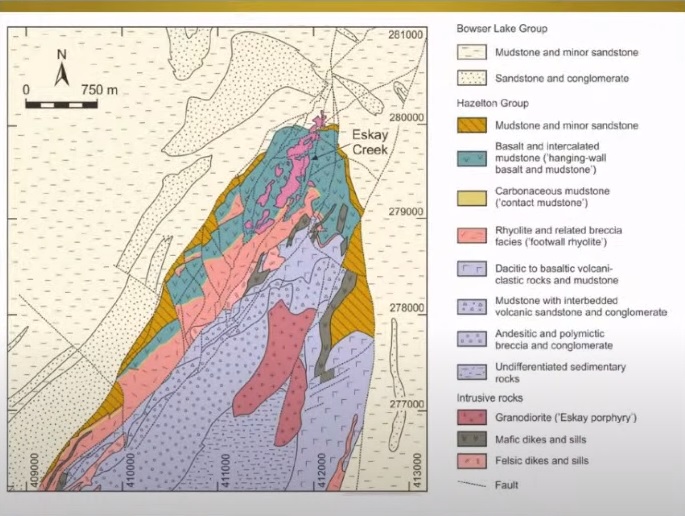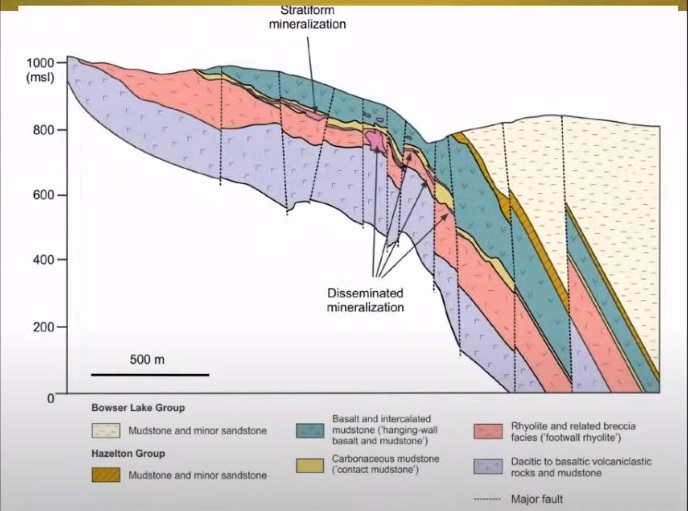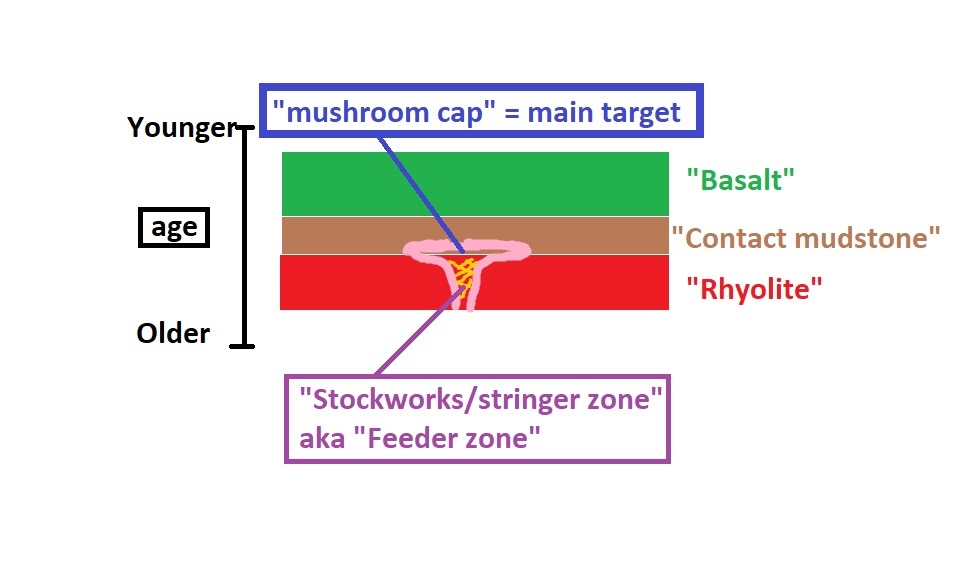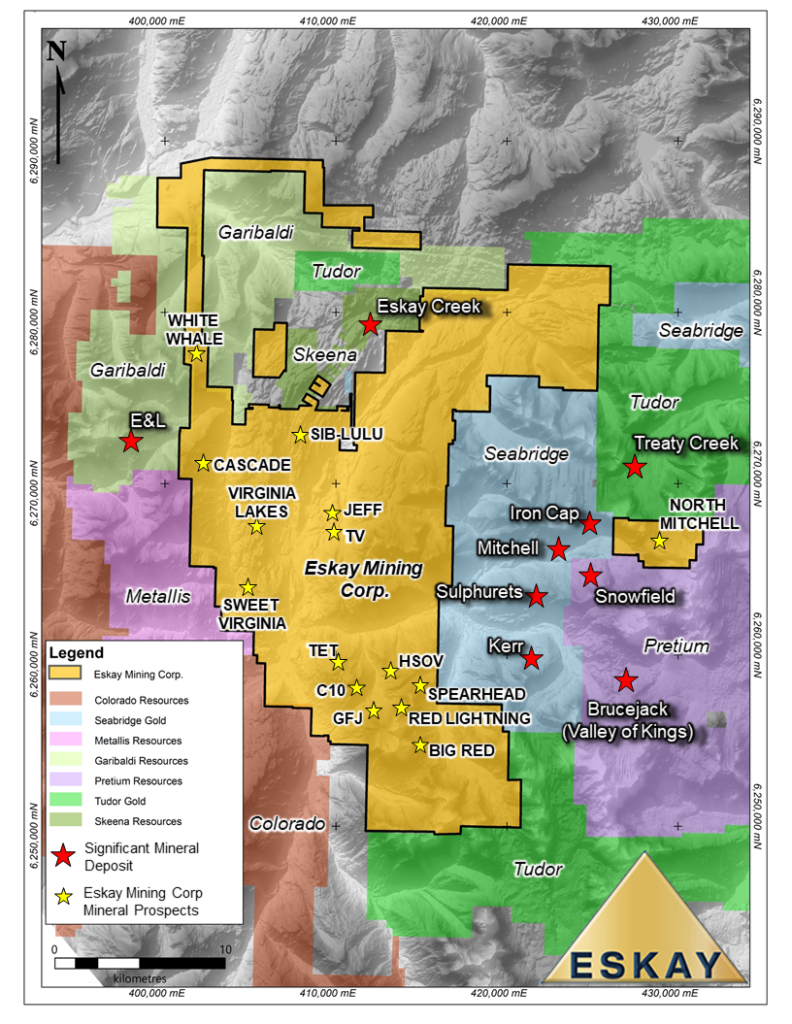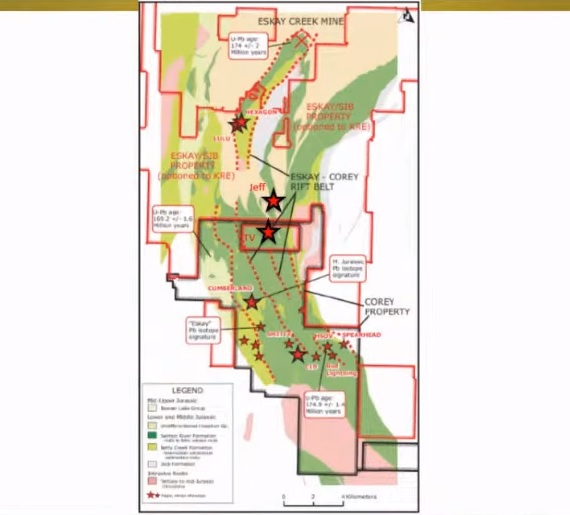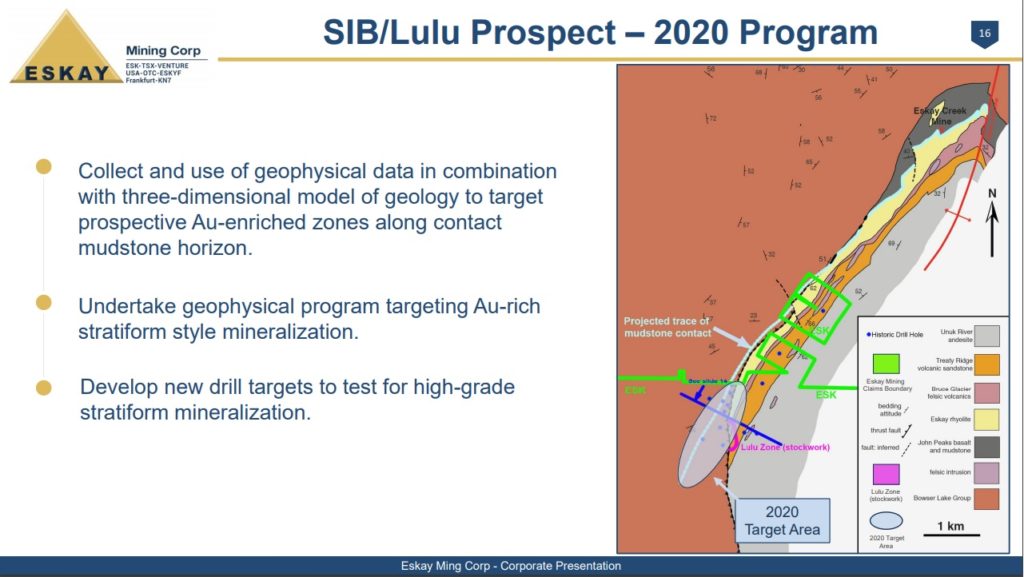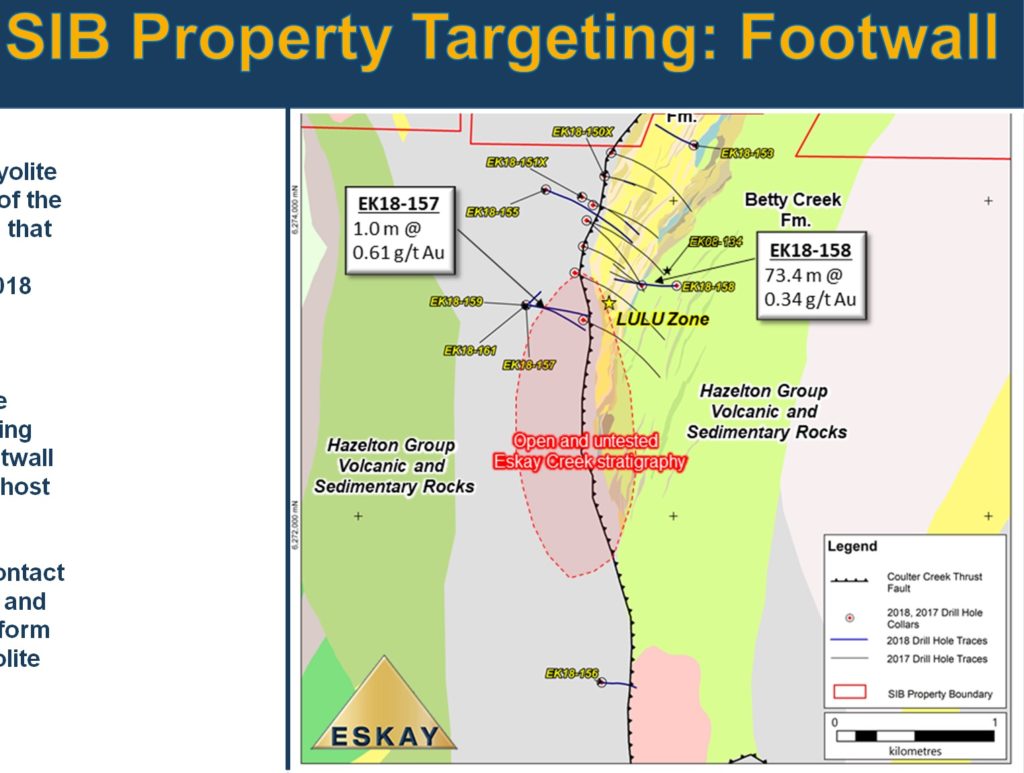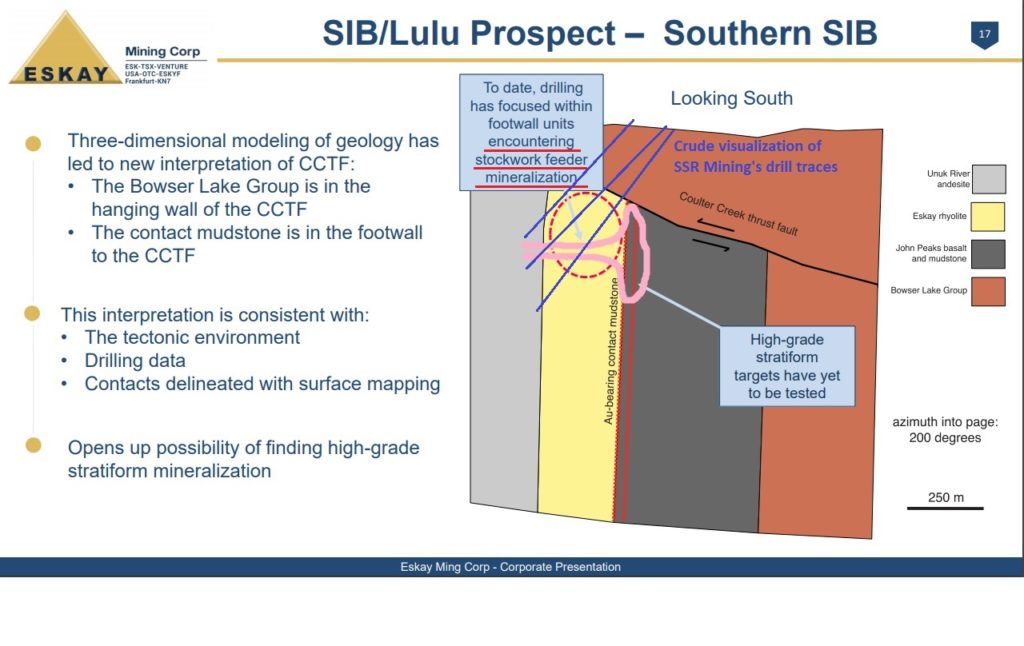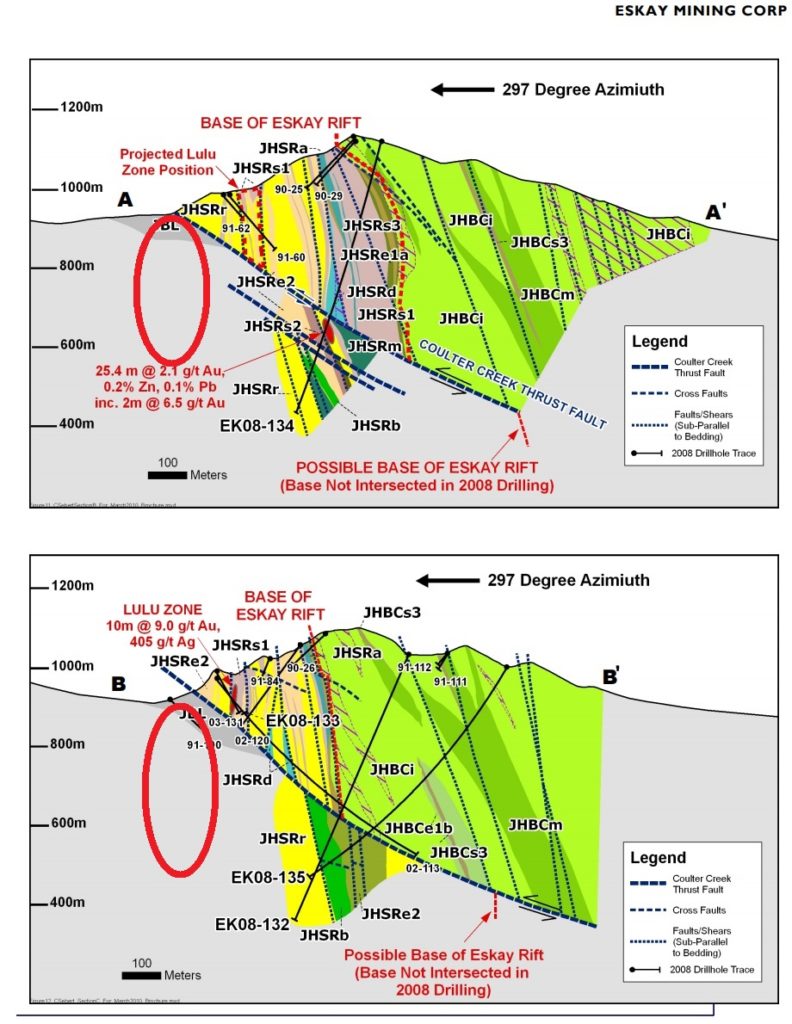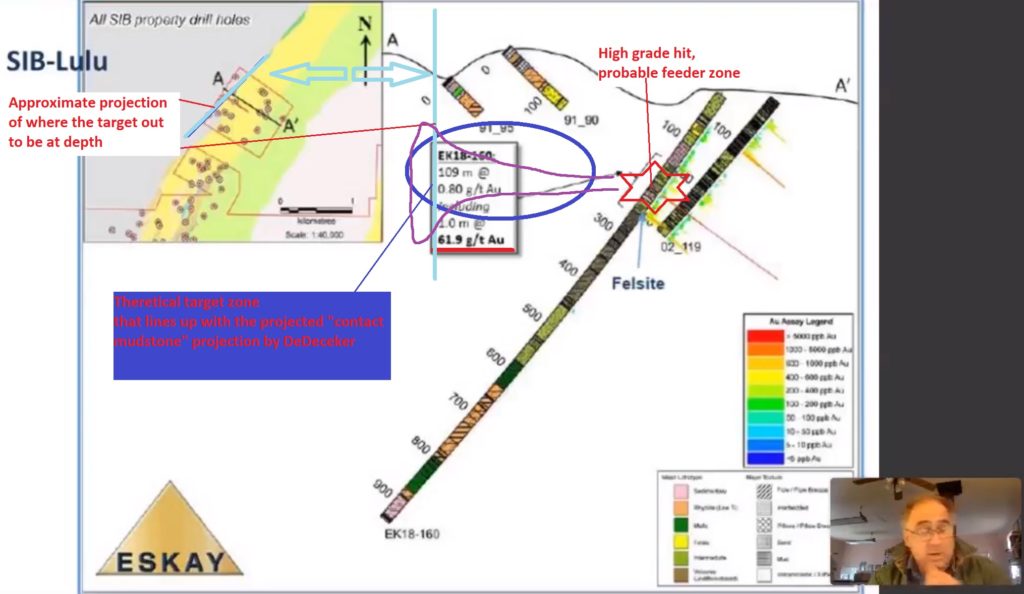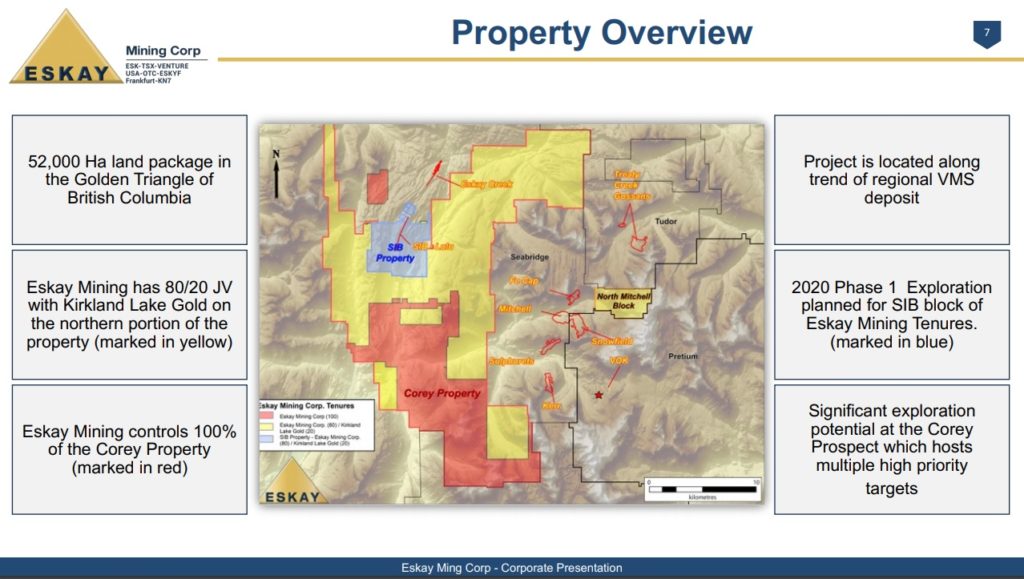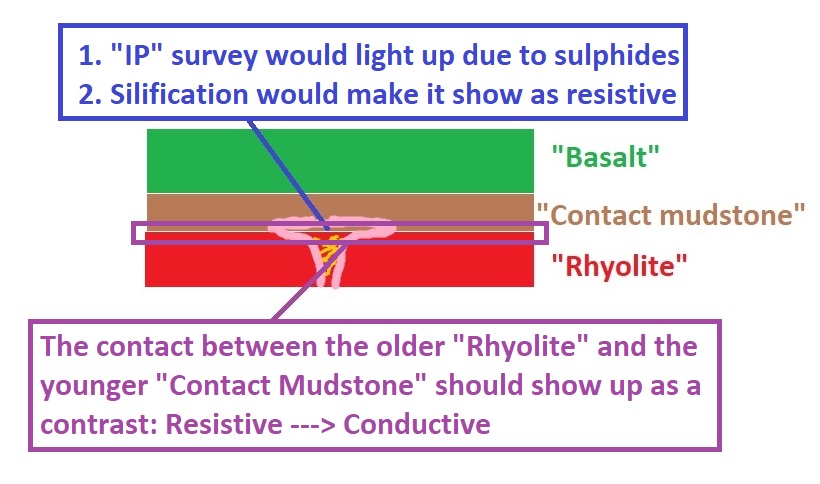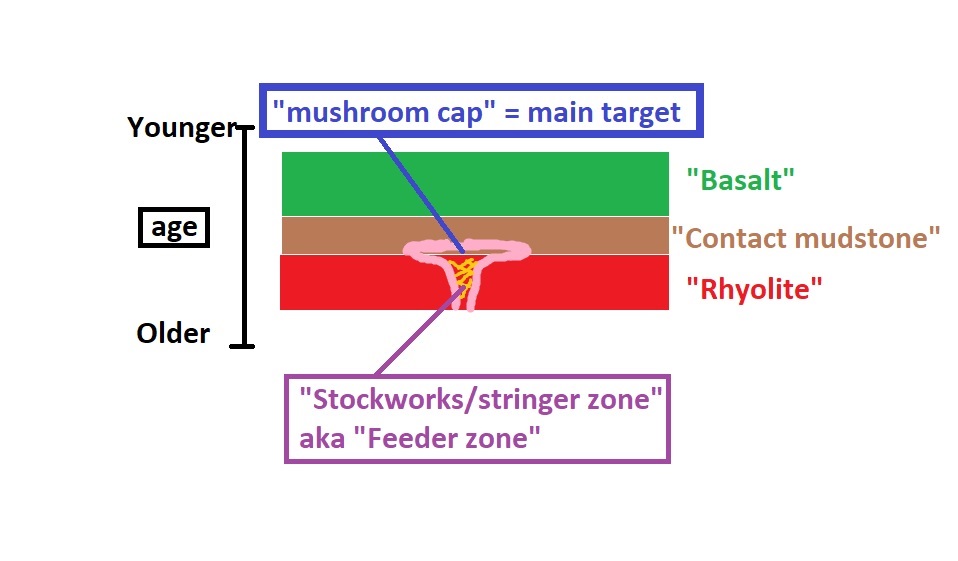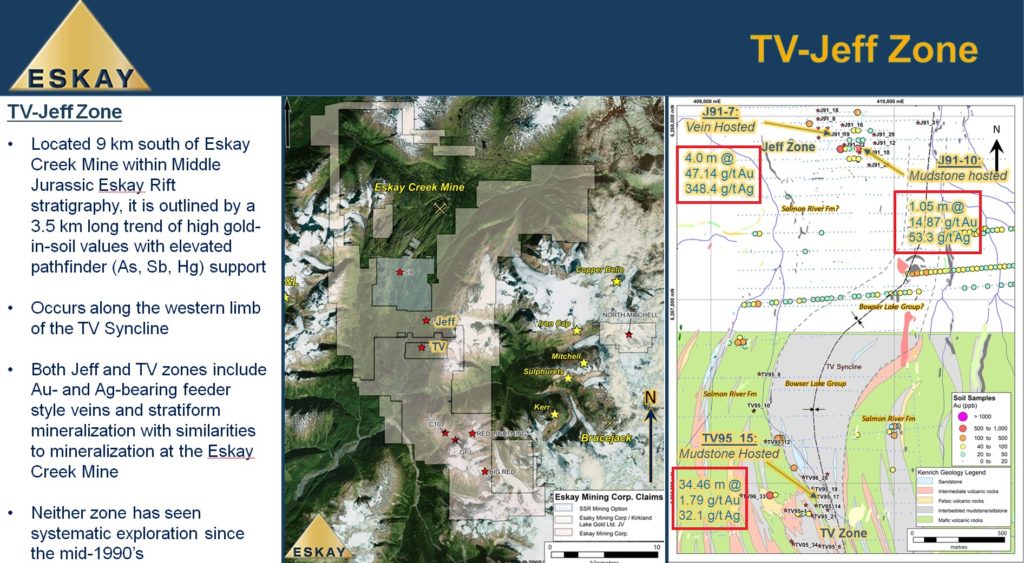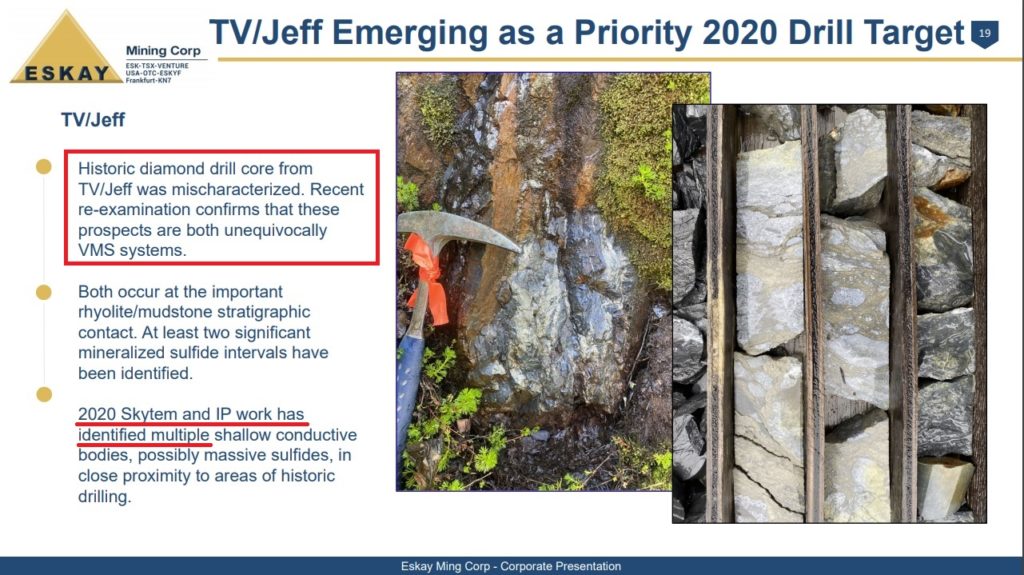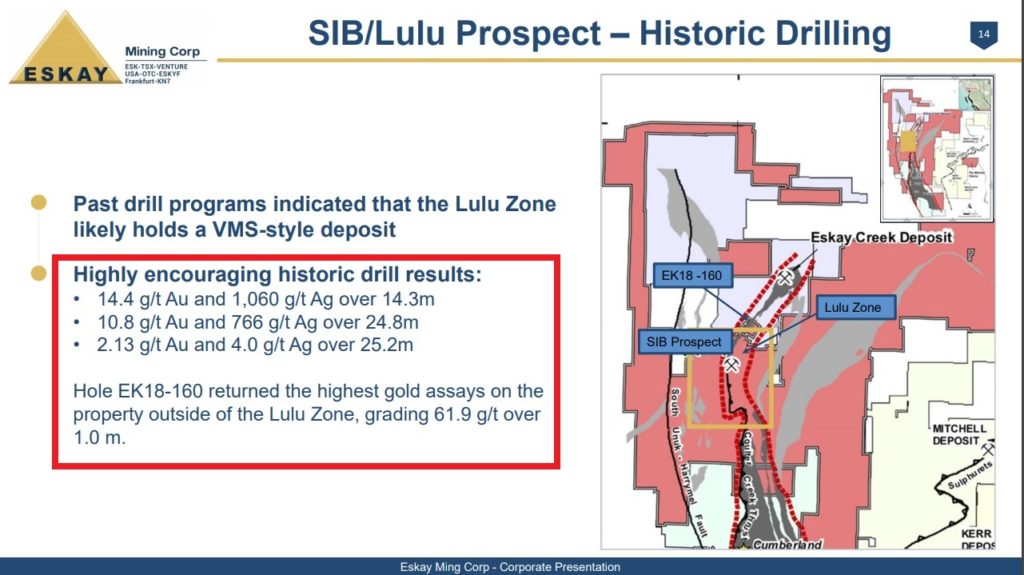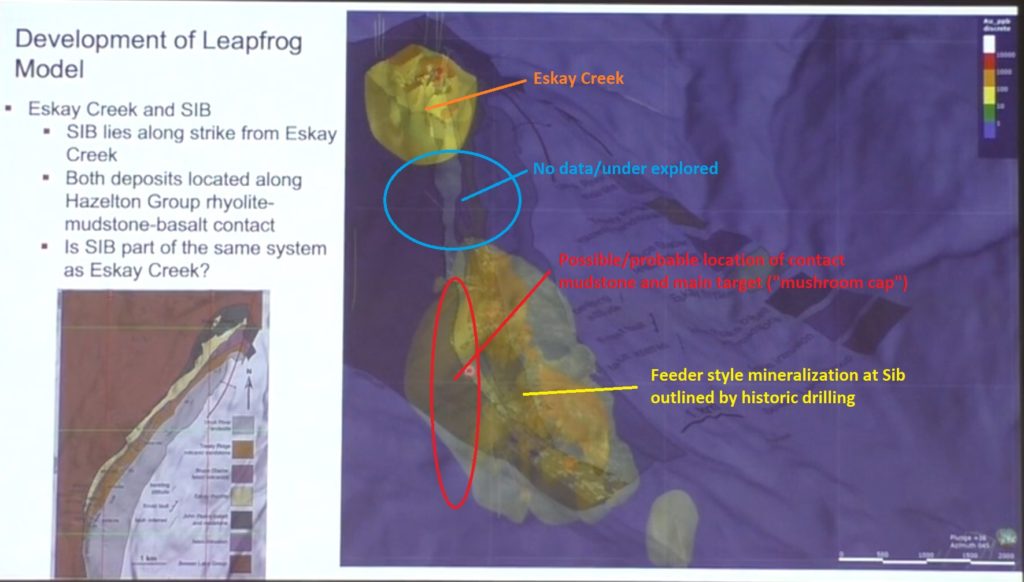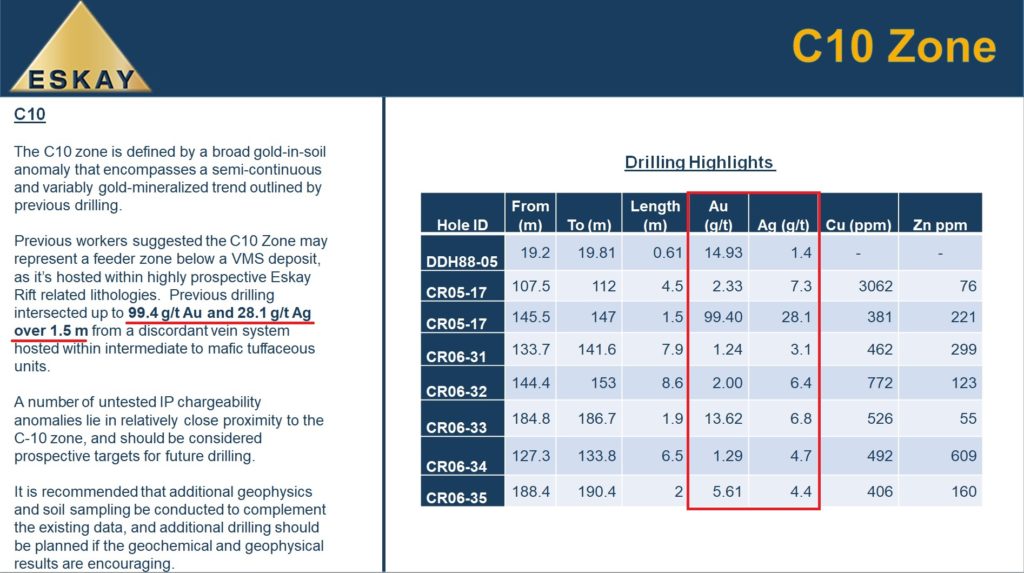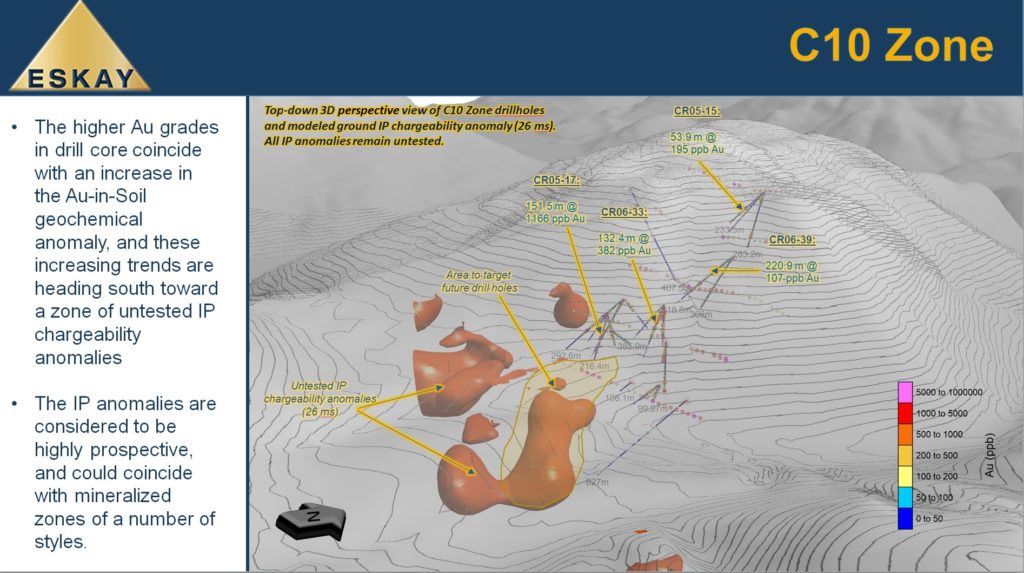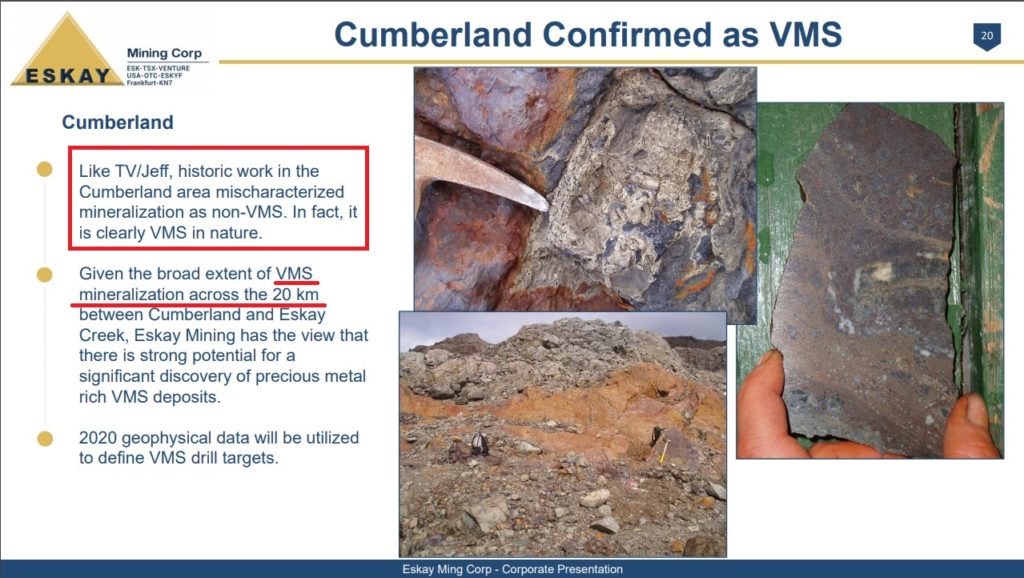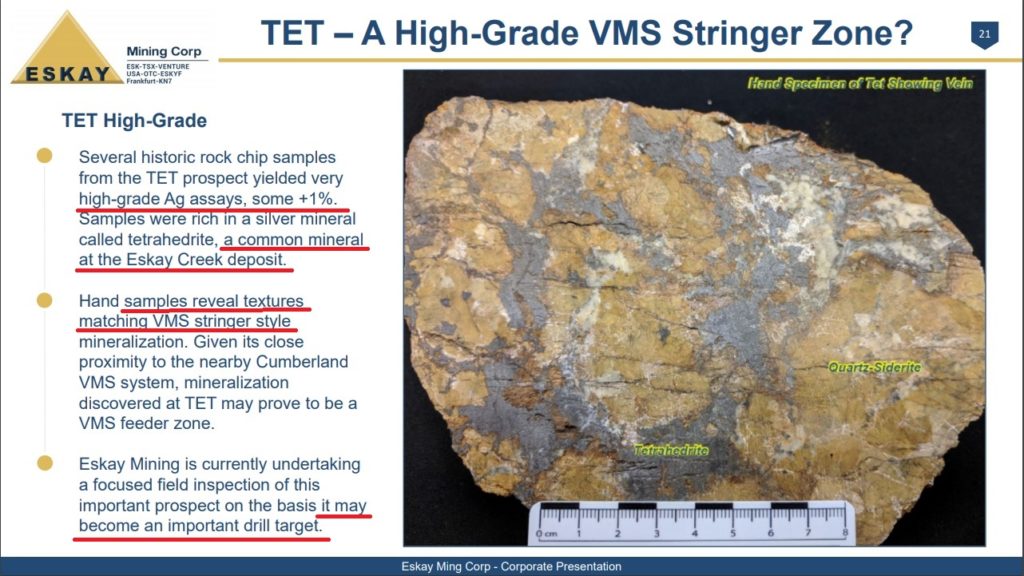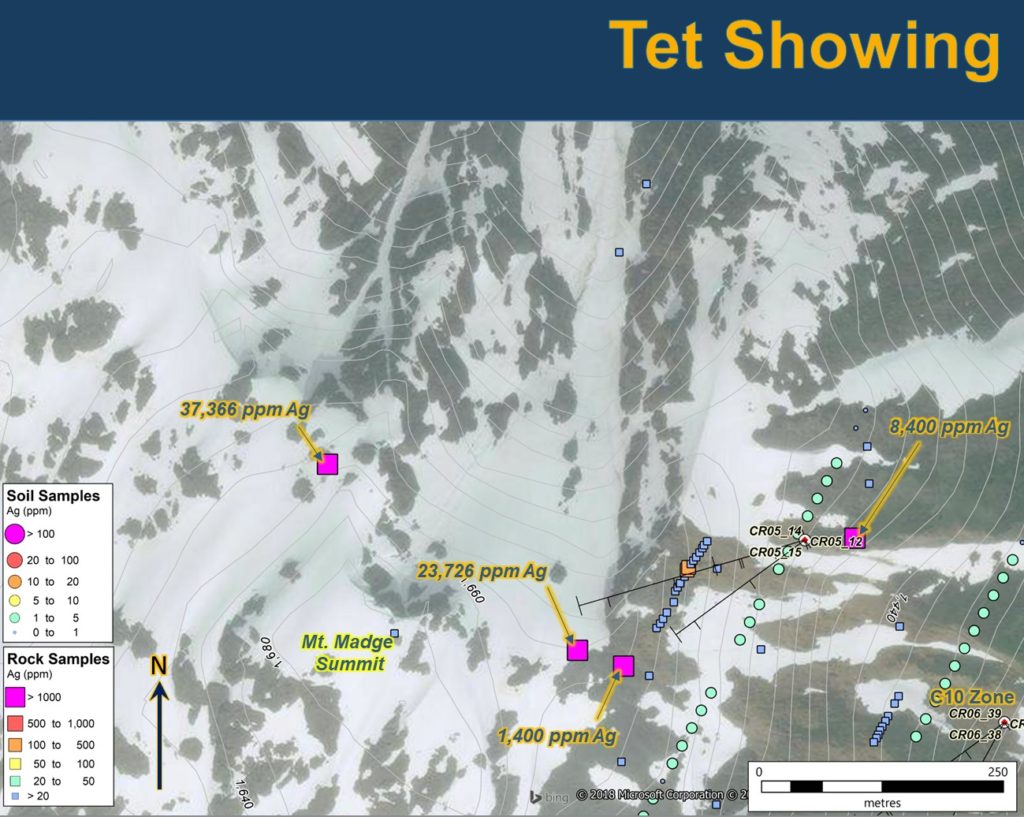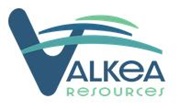Eskay Mining: 52,600 Hectares And Multiple Targets Within The Eskay Creek Rift
This is an introduction article to Eskay Mining Corp which is a junior explorer with a district scale land package within the Eskay Rift in British Columbia, Canada. I like the story and was happy to be able to get the company on board as a banner sponsor of The Hedgeless Horseman.
Eskay Mining in Short
- Website: LINK
- Presentations: LINK
- Ticker: ESK.V
- Shares outstanding (pre financing): 130.6 M
- Market Cap at C$0.63/share: US$58 (C$82 M)
- Project(s): 52,600 Hectares in British Columbia, Canada
- Kirkland Lake Gold has a 20% stake in some areas
- Examples of current targets which are confirmed to be VMS systems:
- TV-Jeff Zone
- One large or two separate systems?
- Sib-Lulu Zone
- One large or two separate systems?
- Cumberland
- TET
- C10
- Red Lightning
- …
- TV-Jeff Zone
- Market Cap per target above: US$9.7 M
The expert people involved in Eskay Mining today is one of the strongest argument for this story in my opinion.
- Dr. Quinton Hennigh, spent a lot of time at the Neves-Corvo VMS deposit in Portugal
- Tom Weis, ex Chief Geophycisist at Newmont Mining
- Dr. Thomas Monecke. Professor at Colorado School of Mines and expert on the Eskay Creek VMS deposit
- Dr. John DeDecker, Post doc at Colorado School of Mines
… You get Quinton Hennigh who spent a lot of time at the Neves-Corvo VMS deposit, two VMS experts from Colorado School of Mines and the ex Chief Geophycisist from Newmont working together with the main goal of finding more Eskay Creek type VMS systems. If those people can’t find any VMS deposits in the Eskay Creek camp I doubt anyone can. An example of what I am talking about is when DeDecker, during his presentation, stated that it took the team about an hour to figure out that the previously used geological model for the area around Sib-Lulu was wrong .
My Case For Eskay Mining in Short:
- The Eskay Creek mine is the highest grade precious metal VMS deposit ever found and would probably be worth over C$4B today
- Eskay Mining probably has the best team possible in terms of being able to understand and find more Eskay Creek type VMS deposits
- 52,600 hectares land package which is surrounded by major mines and on strike from the Eskay Creek Mine
- Potential for both Eskay Creek type VMS and Porphyry deposits
- Eskay Mining’s geological team has probably already figured out what previous explorers did wrong
- Eskay Mining’s geological team understands the geology and know where and how to explore for more Eskay Creek VMS systems
- Ex Chief Geophycisist at Newmont Mining will be in charge of all the geophysics surveys to help hone in on the targets
- After re-logging core from SEVEN known prospects the team has confirmed that limited and faulty historic exploration efforts have actually been able to locate SEVEN VMS systems that might be Eskay Creek VMS type
- … What this means is that they KNOW that they got at least SEVEN VMS systems, probably Eskay Creek type, by their tails already
- These seven targets are “just” the ones identified SO FAR and the company will do property wide BLEG sampling surveys etc for additional target generation
Lastly I would say that Eskay Mining might not look cheap on surface but when accounting for the amount of targets that are already de-risked, in terms of the presence of multiple VMS systems already being confirmed, I don’t think it’s expensive. If you consider the Market Cap per de-risked target then one could say one is paying around $10 M per target, pre financing. Given how much smoke has already been hit (14.4 gpt + 1,060 gpt Ag over 14.3m and 10.9 gpt Au + 766 gpt Ag over 24.8m etc) in some of these targets I would argue there is a real chance of findings something akin to the Eskay Creek deposit. Another example is the target called TET, which has seen surface rock chip samples grading up to 37,000 gpt Ag, and the Eskay Mining team suspect it is from a VMS feeder zone. In that case not much is priced in obviously. Basically you get multiple shots at something that might be akin to one of the best mines ever found in one company and many of the targets are already confirmed to be VMS systems through re-logging of historic core.
You will find my “extended case” at the end of the article.
Setting The Scene
– What is a VMS deposit?
VMS stands for Volcanic Massive Sulphides and are deposits that originally formed on the sea floor around a complex of hydrothermal vents called “black smokers” and/or “white smokers”. A “black smoker” vent is basically an underwater “chimney” that spews out sulphides, which contains metals, from deeper parts of the earth’s crust:
Here is a close up of the top of the system, near the sea floor:
The actual bulk of the deposit will be formed on top and/or immediately in the uppermost parts of the sea floor since the hot hydrothermal fluids will start to “shed” its metallic load as the fluids rapidly cool down once they reach the much colder sea. In other words it basically means that as these black smoker vents spew out hydrothermal fluids from the ocean floor it starts to “rain” down a smorgosbord of metals around these vents. The hydrothermal fluids come up through the “alteration pipe” and as it gets closer to the sea floor there is a “stockwork/stringer zone” that forms in the guts of the system all the way up to the final venting area. This is important to understand because it means that if you find the “stockwork/stringer zone” of a VMS system you have basically found the feeder zone of the system that will eventually lead up to the venting area where these metals would have been spewed out in bulk on what was once the sea floor.
VMS deposits typically form in clusters or “VMS camps” if you will. This means that if you have found one VMS deposit it is statistically likely that there are others nearby. The Bisha mine in Eritrea is for example a famous VMS deposit that now belongs to Zijin Mining since it acquired Nevsun Resources. Again, as is typical with VMS deposits they do not form in isolation and there has already been several other VMS systems found around the original discovery:
In fact there is at least 7 additional VMS deposits that have been found within a 20 kilometre radius from the Bisha VMS deposit. This is of course important when it comes to Eskay Mining because balance of probabilities would suggest that it is statistically unlikely that the Eskay Creek VMS deposit is the only VMS deposit that was formed in that district in BC, Canada. On that note, the VMS expert team at Eskay Mining has already confirmed the presence of multiple VMS systems on Eskay Mining’s ground, which I will come back to later.
To give you a better idea of how these VMS systems looked when they were forming I present you with this slide which includes a topographic map of the ocean floor where there are multiple “hydrothermal vents” active today:
This next slide is a schematic of the “Solwara” VMS deposit which was found by Nautilus and which is present on the actual sea floor today(!):
… You can clearly see a bunch of black smokers or “sulphide chimneys” that have spewed out a lot of sulfides (metals) in the immediate area. Note that Solwara is certainly not a large VMS deposit, but the grades are incredible, and there is a whopping 18 additional deposits found in the immediate area. Again, VMS deposits are usually not the biggest ones around but they can be incredibly rich and they usually form in clusters. The slide above is also another good illustration of how the a VMS system is like a mushroom, where there is a relatively narrow feeder zone that leads up to a much more extensive mineralized area, at/in the sea floor like a cap… If you find a VMS feeder zone, you know there should be a VMS cap that could host a lot of mineralization nearby, at the end of it.
Why is Eskay Mining Looking For VMS Deposits in The Eskay Creek Camp?
Well first of all it is because a certain deposit called Eskay Creek was found the area. This deposit just so happens to be a VMS deposit and it was not your typical VMS deposit. In fact it was/is the highest grade precious metal VMS deposit that has ever been found:
There are not that many mines in the world with a grade of above 10 gpt of gold. Keep that in mind and then look at the following slide:
… Just to give you an idea of how insanely rich it was you should listen to the part of the Crescat/Quinton presentation where Quinton talks about the Eskay Creek mine. In short, it was so obscenely rich in gold and silver that it allegedly produced gold for -$200/ounce, when gold was trading at around $256/oz and silver around $5/oz, towards the end of the 1990’s. This during the deepest depths of the precious metal bear market. The mine was so outstanding that it was first acquired by Homestake Mining and then Homestake Mining was acquired by Barrick mainly due to the fact that Homestake Mining owned Eskay Creek. Quinton mentions that (unsurprisingly) it was the best performing asset in the gold mining industry at the time.
This is what one tonne of Eskay Creek ore would be worth today:
A whopping US$4,943 per tonne(!). Compare that to a gold mine with an average ore grade of 5 gpt which is worth US$318/tonne. Lets just say that Eskay Creek would be the last mine standing in a gold bear market.
The Gift That Keeps on Giving
What is interesting is that the Eskay Creek story did not reach its end when the high grade core was mined out because Skeena Resource currently owns the Eskay Creek mine property and might have a very good mine “just” based on the remnant lower grade material that was left by Barrick. In fact, the 2019 PEA on these “remnants” ounces showed an after tax NPV of $878 M and an after tax IRR of 62.% at $1,500 gold. At today’s gold price the projected NPV should obviously be well over a billion dollars. Again, this is from the lower grade remnants which means that there is at least around $1 B of value left in the ground today, in addition to the mine having been the best performing asset in the space during its prime. I find this remarkable given that a deposit worth $1 B is something few juniors even hope to have and that’s the value derived just from the “scraps” of the Eskay Creek mine. This obviously means that finding an Eskay Creek type deposit would be worth multiple billions of dollars today.
Where Should One go Look For Another Eskay Creek deposit?
Below is a geological map over the Eskay Creek deposit where the mineralization is projected to surface (in pink):
And this is a cross section of the Eskay Creek deposit (again, mineralization is in pink):
The mineralization at Eskay Creek is found in/near the light brown “contact mudstone” layer which is sandwiched between the reddish “Rhyolite” layer and the greenish “Basalt” layer. Basically the reddish stuff was some kind of lava that was laid down on the sea floor during a major volcanic event. It might have been said event that then created a lot of heat and led to the formation of hydrothermal vents (black smoker complexes) on the new sea floor. These black smokers would then be the chimneys that started spewing out a lot of sulfides (metals). The sea floor, including the then formed Eskay Creek VMS deposit, was later covered by mudstone (“contact mudstone”) which is the lightbrown unit. Sometime later the area was again covered by a new lava flow which covered and encapsulated the “contact mudstone”…
The Geological Blueprint For More Eskay Creek Type VMS Discoveries
What is described in the previous sections means that:
- Eskay type mineralization should be in/near the “contact mudstone” unit in the Eskay Creek district
- Where you have the greenish “Basalt” unit you know you are in younger rocks and that the targeted “contact mudstone” might be just below it
- Where you have the reddish “Rhyolite” unit you know that you are in older rocks and that the “contact mudstone” horizon might be just above it
- This also means that VMS Stockwork/stringer zones aka “feeder zones” should be found within this older “Rhyolite” unit since it was deposited just before the “contact mudstone”
We also know that:
- VMS systems have a “stockwork/stringer zone” aka “feeder zone”, that lead up to the sea floor, where the bulk of the sulfides (metals) were then deposited around a black smoker complex (aka “chimneys/vents”)
- … Which means that if you find a VMS stockwork/stringer zone you know you have a VMS system by its tail and that the mineralized “mushroom cap” should not be far away
… This would be the geological blueprint when searching for more VMS deposits in the Eskay Creek district that formed on the sea floor during the same time period that the “black smokers” (“sulphide vents”) which created the Eskay Creek VMS deposit were active.
Visualized:
Schematic of Eskay Type VMS deposits:
Make sure you get the concepts outlined above before you read on otherwise it will be harder to keep up when I describe what Eskay Mining team is and have been doing.
Enter Eskay Mining
By now it should be beyond obvious why everyone and their mother would want to find and own an Eskay Creek type deposit. Well it just so happens to be that Eskay Mining controls the lion’s share of the ground on strike from Eskay Creek where the same rock packages are present:
Another map where you can also see that the outcropping geological units extend all the way from the Eskay Creek mine to the southern parts of Eskay Mining’s land package:
As you can see in the slides above Eskay Mining controls a vast land package where the basalt (Dark Green), that would have capped the “contact mudstone” target unit, is present today. This is of course a really good thing because it means that if there were more Eskay Creek type VMS deposits that formed in the district way back when they will not have been eroded away where the basalt cap is still present. On that note, note how many targets and known prospects are already outlined within Eskay Mining’s land package.
Why People Matter
This is just going to be a short segment where I describe some of the mistakes that seem to have been done by prior explorers which helps explain why only one VMS deposit has been found in this district so far…
First of all geology and exploration is obviously not easy. It becomes almost impossibly hard if you have the wrong geological framework and this the wrong blueprint for discovery. A good example of this is the fact that it seems that the previous explorers, including SSR Mining, mistook the “hanging wall”, around the Sib-Lulu area, of being the “foot wall”. During DeDeckers (advanced) presentation he highlights where the Eskay team believes the “contact mudstone” (main target) is present on strike from the Eskay Creek deposit:
Note how the “Projected trace of the Mudstone Contact” runs under the brown unit in a northeast-southwest direction from the Eskay Creek mine which is located to the north-east. Basically it means that the “contact mudstone” that hosts the Eskay Creek VMS deposit should be located under the edge of where the brown unit is outcropping today. By the way, the reason why it’s a thin line instead of a horizontal horizon is because the rock packages have been folded so what was once a horizontal sea floor has been turned vertical today. Anyway, previous explorers including SSR Mining seem to have interpreted it backwards judging by the drill traces in the slide below:
… You can clearly see why those drill holes would have missed the projected “contact mudstone”. The slide is from Eskay Mining’s 2019 power point presentation so this is how the geology was interpreted up until the current team of VMS experts digested all the data. Notice how the drill collars are pretty much on top of the grey unit (which is the brown unit in the previous slide) and they were pretty much all drilled towards the east. So when, according to the VMS experts at Eskay Mining, they should have been drilling from east to west they instead drilled west to east. Basically SSR Mining et al thought they were drilling towards where the VMS “mushroom cap” target was thought to be located but instead they drilled the opposite way:
(Drawings added by me)
To be fair I guess they might not have thought that it was going in the opposite direction butNote how the Eskay Mining team has drawn the “Coultier Creek Thrust Fault” in the slide above (That the “Bowser Lake Group” of rocks have been pushed up and over the other rock packages. This is the orientation it allegedly took just an hour for the team to figure out. Compare that to the assumptions that some of previous explorers have used:
(Not that his slide is looking north, instead of south, as the previous slide did)
… Here you see the exact opposite. Namely that the other rocks have been pushed up over the unit named “JBL” which is the name of the “Bowser Lake Group” in this schematic. The red circle drawn by me is an approximation of where the Contact Mudstone might be really hiding given DeDecker’s projections. It might even be farther to the west. Still the fact remains that this area wasn’t even deemed as a target during the time when the slide was made.
If the Eskay Mining team is correct, and I have no reason to believe otherwise, then it’s not surprising that the previous explorers never found the bulk of the VMS system at SIB/Lulu given that they had mixed up the geology and were looking in the wrong direction. The somewhat amusing and very positive thing for Eskay Mining is that SSR Mining actually hit a feeder zone during one of the last drill attempts. They still had the wrong idea about orientation and believed they were drilling the “hanging wall” when they were likely drilling the “foot wall”. Anyway they seem to have hit the stockwork feeder zone (1m @ 61 gpt) despite this which means that Eskay Mining now know a) Where there is a feeder at SIB and b) What direction they should actually drill. Quinton explains this in one of his presentations and theorizes that the real target might be located directly under two other holes that were drilled too shallow:
(Drawings added by me)
Actually the gold bearing area that Eskay believes to be a VMS feeder zone is a lot thicker than the red star as evidenced by the 109m interval at 0.8 gpt which INCLUDES the 1m at 61 gpt interval.
To Sum Up
Previous explorers got the geology wrong and were mainly looking for the mineralized “cap” of the system while drilling in the wrong direction at Sib-Lulu. Despite this they were able to hit the feeder zone, which was confirmed by DeDecker in his presentation, in one of the last drill holes that SSR Mining did before they terminated the option agreement in 2018. In other words there is definitely a VMS system there, on strike from the Eskay Creek deposit, and now its up to Eskay Mining to find it armed with the correct geological model.
DeDecker mentions other mistakes done by previous explorers during his presentation. One example is wrongfully logging core intervals as “basalt” when they were in fact “rhyolite”.
What Eskay Mining has Been Doing
Late last year Eskay Mining brought in the A-team:
TORONTO, ON / ACCESSWIRE / October 16, 2019 / Eskay Mining Corp. (“Eskay” or the “Company”) (TSXV:ESK)(OTCPK:ESKYF)(Frankfurt:KN7; WKN:A0YDPM) is pleased to announce that it has teamed up with one of the world’s leading economic geology research teams, the Colorado School of Mines (“CSM”) to enhance its chances for discovery at its Eskay Creek area properties, the SIB and Corey. The research team is led by Dr. Thomas Monecke, Associate Professor of Economic Geology, a globally renowned expert in volcanogenic massive sulfide (“VMS”) deposits. His post-doctoral research encompassed the geology and formation of Barrick’s world class and extremely high-grade Au-Ag-rich Eskay Creek VMS deposit (3.7 million oz Au at a grade of approximately 45 grams pre tonne(“gpt”) and 162 million oz Ag at a grade of approximately 2,100 gpt), situated 2 km north of Eskay Mining’s extensive land holdings. Dr. Monecke will be working in close collaboration with Dr. John DeDecker on this project. Dr. DeDecker (Ph.D. Geology, CSM) will be conducting a post-doctorate study on geochemical vectoring to ore deposits, in particular on how it pertains to VMS exploration.
Drs. Monecke and DeDecker join Dr. Quinton Hennigh P. Geo. and Charles Greig M.Sc. P.Geo., (technical advisors to the Company), Thomas Weis (Chief Geophysicist), , and geologists Neil Prowse M.Sc. and Andrew Mitchell P.Geo, who ran the 2017 and 2018 exploration programs on Eskay’s SIB property, in an effort to better outline high-value exploration targets, and to better understand their geologic framework. Collectively, Eskay Mining’s technical exploration team will comprise one of the most capable in the Golden Triangle of northwest British Columbia, and should be especially capable of designing and implementing exploration for Eskay-style VMS deposits.
… This is far far, your average junior mining exploration team. This might be the best team in the world in terms of specifically finding more Eskay Creek type VMS deposits. Dr. Monecke has studied the Eskay Creek deposit in depth. DeDecker has been working full time for Eskay Mining since he joined and have been very busy re-logging a lot of core that was drilled acorss multiple targets. Dr. Hennigh spent a lot of time at the Neves-Corvo VMS deposit which is located in Portugal. Tom Weis is the ex Chief Geophycisist for Newmont Mining which has also helped Lion One Metals in Fiji for example (Lion One recently drilled one of the best holes I have seen this year).
So we know what geological unit to look for, which is the “Contact Mudstone”, but…
What is Eskay Mining Doing to Find Said Unit?
Eskay Mining is and have been doing a lot of things in order to hone in on mineralization across multiple targets according to the June 22 NR:
- An airborne Skytem electromagnetic survey using helicopter support
- Areas to be surveyed are illustrated in Figure 3 and include: 1) The approximately 90 sq. km central core of the Eskay volcanic graben, or geologic trough, thought to be the most highly prospective area for further discovery of high-grade Eskay Creek style Au-Ag volcanogenic massive sulphide (“VMS”) mineralization, and where precious metal-rich VMS mineralization has been identified at the SIB-Lulu, Virginia Lakes and TV-Jeff prospects; and 2) The North Mitchell block which is adjacent to multiple world class porphyry Cu-Au deposits. The North Mitchell block is situated immediately east of the world class KSM porphyry Cu-Au deposits (Seabridge Gold Inc.), south of the new Treaty Creek discovery (Tudor Gold Corp and Teuton Resources Corp), and north of the Brucejack gold mine (Pretivm Resources Inc.). Skytem is designed to identify areas of conductive rock as well as map out areas of resistivity such as places where hydrothermal silicification may be present. The Company views Skytem as a reasonably cheap yet effective way of quickly identifying potential drill targets.
- Ground based induced polarization (“IP”) and magnetotelluric (“MT”) surveys
- These surveys will be conducted at three locations: 1) The SIB-Lulu area which is the geological strike continuation of the Eskay Creek deposit; 2) The TV-Jeff area where historic drilling intersected precious-metal rich VMS mineralization approximately 5 km south of SIB-Lulu; and 3) The Corey target field that includes the C10, TET, HSOV, GFJ and Red Lightning, all currently of undefined mineralization style (HH: I will get back to this later!). IP highlights electrically chargeable rock including that containing significant sulphides, potentially associated with mineralization. MT provides deep looking resistivity data that can assist with stratigraphic interpretation as well as identify areas with potential hydrothermal silicification. Like Skytem, Eskay Mining thinks IP and MT data will help quickly identify potential drill targets.
- A property wide bulk leach extractable gold (“BLEG”) stream sediment survey
- Clay fraction stream sediment will be targeted for sampling. Such material yields the most sensitive gold, pathfinder element, and base metal signal. This program will better define known mineral occurrences but also potentially reveal new areas of mineralization. It is anticipated that data from this program will drive further geological and geophysical work as new mineral discoveries are made. Importantly, the North Mitchell block will be surveyed, the first geochemical work done on this important target to date.
- A property wide light detection and ranging (“LIDAR”) and high-resolution imagery surveys
- Such a surveys yield very fine resolution elevation and photographic data that are very useful for identifying structural controls including those associated with mineral targets.
- Geological and geochemical re-logging of historic drill core
- The goal of this program will be 1) to further refine the new geologic synthesis of the SIB-Lulu target, to develop a better understanding of the TV-Jeff VMS occurrence with an eye toward vectoring future drill targeting, and 3) to better understand the nature of mineralization at the Corey target field and help define future targets there.
Comments:
I really like that the team is taking a district wide approach in that the “BLEG” sample program will be done property wide. Eskay Mining’s property is very large at 52,000 hectares and it is surrounded by multiple major deposits of different types:
“BLEG” sampling should readily highlight any areas where there is outcropping mineralization today. The two things I find most intriguing in the previous list of exploration tools is the Induced Polarization (“IP”), “Skytem” and Magnetotelluric (“MT”) surveys combo. The IP survey will highlight electrically chargeable rock, which includes rock that contains significant sulphides, and a Volcanic Massive Sulphides (“VMS”) deposit will obviously contain a lot of sulphides. However, since there will probably be other areas in the ground that is not a VMS deposit but which will give a response as well, Eskay will also do “MT” and “Skytem” surveys. Why? Because if I understand it correctly they will help to spot where the contact/contrast is between the conductive “Contact Mudstone” and the resistive foot wall “Rhyolite” as well as areas of silification (rocks that have been altered by hydrothermal fluid). This of course makes perfect sense given that:
- If an area of electrically chargeable rock is higlighted by the IP survey…
- AND shows up as a resistive feature by Skytem/EM…
- AND is proximal to an area where the rocks broadly go from say conductive to resistive (contrast)…
Then it might suggest that:
- There might be sulphides in the rocks (potentially spewed out by Black Smokers)
- The rocks have been silicified by hydrothermal fluids (mineralizing fluids)
- The rocks are located in/near the contact between the “Contact Mudstone” and the foot wall “Rhyolite”
This is what Quinton said when he was asked about geophysics during the latest Eskay Mining presentation:
“At this point in time I can tell the audience here that the status of geophysics has improved dramatically over the past few years… We are to the point where we can identify… In very discreet terms… With high precision… Uh targets that are shallow that are seasily drill testable… I anticipate having a number of such targets by the end of this year.. I think it’s going to turn out to be a very exciting story where we can present to the market… Very very solid evidence that we have a VMS camp in our property here.”
The Above Visualized (my interpretation):
… This combination should really help triangulate and identify the main targets which are the “mushroom caps” of these VMS systems that were deposited on the ancient sea floor through accumulation of a lot of sulphides that got pumped out from the black smoker vents. On that note, remember this line from the June 22 NR which I highlighted in blue earlier:
“The Corey target field that includes the C10, TET, HSOV, GFJ and Red Lightning, all currently of undefined mineralization style.”
Fast forward to just a couple of weeks later, namely July 14, when we got this extremely important news release:
Highlights from the 2020 Exploration Program:
- Recent review of historic diamond drill core from holes drilled at numerous prospects within Eskay’s land tenure indicates that these systems all display a volcanogenic massive sulphide (“VMS”) affinity.
- Cumberland Prospect: Precious and base metal bearing core from this prospect displays textural and mineralogical characteristics typical of footwall feeder style VMS mineralization. Interestingly, the host rock to this mineralization appears to be rhyolite, quite possibly the same rhyolite that comprises the footwall of the Eskay Creek deposit located approximately 20 km to the north. Given there has been no prior recognition of this important unit in this area, this is a potentially important discovery and means that the Cumberland VMS system likely formed during the same time period and at the same stratigraphic position as Eskay Creek. In terms of exploration potential, Eskay Mining thinks there is now good potential to find more VMS mineralization in the vicinity of Cumberland.
- Like core from Cumberland, precious and base metal bearing core from the Red Lightning Prospect appears to be footwall feeder style VMS mineralization hosted by rhyolite. Given Red Lightning is approximately 7 km southeast of Cumberland, this opens up further possibility that significant extensions of the Eskay Creek VMS camp are present in this region, nearly 25 km south of the Eskay Creek deposit.
- Precious metal rich core from the C10 Prospect situated between Red Lightening and Cumberland appears to contain abundant sulphate minerals including anhydrite and possibly barite in addition to sulphide minerals. This mineralogy suggests a possible “white smoker” origin. White smokers, like black smokers, form from sea floor hot springs, but result in accumlations of sulphate minerals rather than sulfides.
- Core from both the TV and Jeff Prospects displays accumulations of precious and base metal bearing sulphides hosted in mudstone that is interbedded with basalt flows. This mudstone may be the same as that which hosts mineralization at the Eskay Creek deposit approximately 13 km to the north. If so, this is the southern most documented occurrence of Eskay Creek mudstone in the region. Interestingly, none of the holes at TV and Jeff encounter footwall rhyolite, the unit immediately beneath high grade mineralization at Eskay Creek, suggesting deeper drilling is warranted in this area.
- Core from the SIB and Lulu Prospects, situated approximately 7 km south southwest of the Eskay Creek deposit, appears to be precious and base metal bearing footwall feeder style VMS mineralization hosted by rhyolite. This implies that exploration for mudstone hosted Eskay Creek style VMS mineralization is warranted in this area. Although mudstone is recognized nearby, this unit has not been adequately tested by historic drilling.
… Holy moly!
This news release is telling us that after the VMS experts at Eskay Mining re-logged the core from these prospects they are now saying these might all be Eskay Creek type VMS systems!!! That’s seven god damn VMS targets already being confirmed and it fits with the geology at the Eskay Creek mine so these VMS systems did probably form at the same time as the legendary mine way back when. Remember the geological blueprint for Eskay Creek to the north of these prospects:
- Cumberland prospect: Footwall feeder style VMS mineralization hosted by rhyolite
- Red Lightning prospect: Footwall feeder style hosted by rhyolite
- C10 prospect: “White smoker” origin (White smokers can show up not far a away from the main Black smoker complex in a VMS system)
- TV and Jeff prospects: Precious metal bearing sulphides hosted in mudstone
- SIB and Lulu prospects: Feeder style VMS mineralization hosted by rhyolite.
Historic Exploration
Given that these geological findings comes from the Eskay Mining VMS experts having examined drill core from these prospects there has indeed been some limited legacy exploration. Below you can read about some of the exploration done at a few of Eskay Mining’s current main targets.
The Jeff-TV Zone
In the Jeff-TV Zone it seems historic drilling has actually been able to intersect both VMS Feeder style mineralization as well as mineralization found in Mudstone. As stated in this slide form an older presentation it might indeed be the same mudstone (the “Contact Mudstone”) that hosts the Eskay Creek deposit many kilometres to the north:
With BLEG sampling and all the geophysical surveys that Eskay Mining should soon have completed I have no doubt that they will get a pretty good idea of where the motherlode might be hiding in this area. Given that 4m at 47.14 gpt Au and 384.4 gpt Ag has been hit there is obviously something going on at Jeff. That coupled with the sniffs in the TV zone, some 2 km farther south, would suggest that this could be a big system(s). On that note Jeff-TV was described as “Emergin as a Priority 2020 Drill Target” in the latest presentation:
The Sib-Lulu Prospects
Sib-Lulu are on strike and cloest to the Eskay Creek deposit:
… 14.5 gpt Au + 1,060 gpt Ag over 14.3m and 10.8 gpt Au + 766 gpt Ag over 24.8m etc. Those are some crazy good hits and considering that previous explorers didn’t really know what they were doing since they looked for the “mushroom cap” (main target) in the wrong place it would obviously suggest that there is a lot of potential here. In his presentation DeDecker points out the fact that if you find a VMS feeder zone you know that the fluids must have gone up to the sea floor (“mushroom cap”) so you know the main target should not be far away. This next slide is from his presentation and in you can see the Eskay Creek mine in the background and areas with confirmed feeder style precious metal mineralization at Sib in the foreground. I have circled an area in red where DeDecker believes the main target should probably be located and you can see that it lines up pretty well given that Sib is on strike from the main Eskay Creek mineralization which is a bit to the left in the top of the slide:
The C10 Prospect
Only a few holes have ever been drilled at C10 and none of them were drilled with the help of any geophysics as far as I know. Still, some holes hit VMS feeder style mineralization and even got some pretty good hits, especially given that this was blind drilling:
A limited IP survey program was done AFTER the limited drilling had been done and it shows that none of the holes hit the proposed targets. In other words these highlighted geophysical targets might be where the feeder mineralization that has been encountered ends up blossoming out to the main “mushroom cap” target:
Again, given that a VMS feeder zone has been hit and the fact that Eskay Mining has perhaps the best Eskay Creek type VMS team possible, I think they have a very good chance of locating the “mushroom cap” with the help of the geophysics surveys that will soon be complete. The main target should not be far away from the feeder so the historic IP targets that are shown in the slide above might very well be where the treasure box for another world class Eskay Creek deposit is located in this area.
The Cumberland Prospect
Cumberland was said to be a clear target during the latest presentation since the team has confirmed that there is indeed a VMS system present here. As stated in the slide above geophysics should help hone in on where the “mushroom cap” of the system is located.
The TET Prospect
The TET prospect is one of the most fascinating targets given the fact that there have been samples found in the area that graded up to 37,000 g/t of silver and the sample in the slide below is believed to originate from a VMS stockwork/stringer zone aka “Feeder zone”. This type of mineralization and grades sounds like something that one would find in an Eskay Creek type VMS system:
The following slide is from an old Eskay Mining presentation and shows some of the incredibly high grade samples that have been found around TET:
Those are obviously some obscene silver grader and there might very well be a high grade VMS system hidden in this area. I think this TET prospect will be covered in the geophysics surveys so lets hope Tom Weis is able to do his magic and hone in on where the treasure box might be.
Quinton Hennigh explaining the case for Eskay Mining:
The Case as I See it
Eskay Mining is simply one of the most promising exploration stories that I currently know of. What these VMS experts have concluded is that there is a high likelihood of no less than seven possible Eskay Creek type VMS systems already being identified. Given that previous explorers did not understand the geology and did not seem to have been doing much more than mostly some limited drilling near soil anomalies I think there is a good chance that the Eskay Mining team will be able to hone in on where the treasure boxes should be located at all seven currently known targets. In other words there is a chance of discovering at least seven Eskay Creek type VMS deposits at the moment. Since the company will do a property wide BLEG sampling program, re-log more core and do a lot of geophysics I think there is also a good chance of additional targets being delineated within the 52,000 hectares distrisct scale land package.
Given that ONE Eskay Creek VMS system would probably be worth several billions of dollars today I can see Eskay Mining having some of the highest blue sky potential of any junior around. If the company is able to discover one or more world class VMS deposits in this area it should obviously lead to some outsized returns that I won’t even put a number on. The fact that this is a tier 1 jurisdiction in Canada is obviously an important part of the story since success here should be worth more than a lot of other places in the world. Furthermore, given the extremely high quality of the people involved I would think that if there was any group of people that were able to find the jewelry boxes of all these confirmed VMS systems it would be this group. You have Quinton Hennigh, an Eskay Creek VMS expert, DeDecker working full time on a lot of things and probably one of the best geophysicists in the world to help with targeting.
The negatives for Eskay Mining is that it does not have any banked success in the form of 43-101 resources that is underpinning the value of the company. This means that it is a pure high risk/high reward exploration play currently. This downside risk must at the same time be compared to the sheer amount of targets that the company has already outlined. Currently there are at least 7 VMS systems, probably/possibly of the Eskay Creek type, that have been identified and proven to host mineralization. Some systems already have some spectacular drill intercepts already confirmed which obviously means that these systems did indeed deposit very high grade precious metal mineralization.
The Risk/Reward
There are currently 7 bullets (and counting) in the chamber for Eskay Mining and one Eskay Creek type deposit could probably be worth over $4 B today. The abnormal upside potential should be obvious. The question is what the odds are that every single “mushroom cap” of these systems will either prove to be too poor and/or impossible to locate? Given that the the Eskay Creep deposit is the only system in this entire district that has been systematically explored coupled with the Eskay Creek system not even being a large VMS system I think there is a relatively high likelihood of there being some Eskay Creep type deposits or even better perhaps.
Upcoming Catalysts
- Property wide BLEG sample results
- Results from multiple geophysics surveys for target generation
- 3,000m of drilling at multiple targets
Note: This is not investment advice. I am not a geologist nor am I a mining engineer. This article is speculative and I can not guarantee 100% accuracy. Junior miners can be very volatile and risky. I have bought shares of Eskay Resources in the open market and I hope to get some more shares in the Private Placement. Therefore you should assume I am biased so always do your own due diligence and make up your own mind. I can buy or sell shares at any point in time. I was not paid by any entity to write this article but the company is a banner sponsor.
Best regards,
Erik Wetterling aka “The Hedgeless Horseman”
Follow me on twitter: https://twitter.com/Comm_Invest
Follow me on CEO.ca: https://ceo.ca/@hhorseman
Follow me on Youtube: My channel



